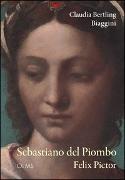Sebastiano del Piombo - Felix Pictor
BücherAngebote / Angebote:
Sebastiano Luciani, genannt Sebastiano del Piombo, wurde um 1485 in Venedig geboren und starb 1547 in Rom. Nach seiner Ausbildung als Maler in der Werkstatt Giovanni Bellinis und Giorgiones erlebte Sebastiano die Initiationsphase des neuen Raumverständnisses in der Kunststadt Venedig unmittelbar mit. Dort machte er sich zunächst als Musiker einen Namen, wird aber in einem Lobgedicht seiner Fresken in Rom, wohin er im Jahre 1511 gewechselt war, als glücklicher Maler - felix pictor - bezeichnet. Nach dem Tod Raffaels galt er dort als bedeutendster Porträtist seiner Zeit. Unter dem Einfluss Michelangelos und dem Kreis der Spiritualisten entwickelte er in der Reformzeit eine neue Bildästhetik. Dabei war sein Kunstbegriff an die musikalische Form der Elocutio geknüpft - so das Ergebnis der vorliegenden Untersuchung.Im Prozess künstlerischer Formbildung entstand mit dem Maler Sebastiano del Piombo ein ästhetisches Konzept von Dauerhaftigkeit und Transformation. Hier ergeben sich deutliche Parallelen zu den Memorialkompositionen Johannes Ockeghems, wie die Autorin aufzeigen kann. Auf der Basis neuer Raum- und Zeitvorstellungen gipfelt die Malerei Sebastianos im klanglichen Memorialbild. Diese neue Bildgattung mit Erinnerungscharakter bereitet die Klanggemälde Caravaggios und weiterer Nachfolger vor.***************Sebastiano Luciani, called Sebastiano del Piombo, was born around 1485 in Venice and died in 1547 in Rome. After studying painting in the workshop of Giovanni Bellini and Giorgione, Sebastiano witnessed at first hand the initial phase of a new understanding of space in the artistic city of Venice. He first made his name there as a musician, but in a panegyric poem about his frescoes in Rome, where he had moved in 1511, he is described as a happy painter - felix pictor. After Raphael's death he was considered to be the most important Roman portrait painter of the time. Under the influence of Michelangelo and the circle of 'spirituali' he developed a new visual aesthetic during the period of reform. This involved linking his conception of art with the musical form of 'elocutio' - that is the finding of this study.With the painter Sebastiano del Piombo a new aesthetic concept of permanence and transformation developed in the process of creating artistic form. There are clear parallels here with the memorial compositions of Johannes Ockeghem, as the author demonstrates. On the basis of new concepts of space and time, Sebastiano's painting reaches its climax in the tonal memorial image. This new genre with its memorialising character paves the way for the tonal paintings of Caravaggio and other successors.
Lieferbar in ca. 5-10 Arbeitstagen

